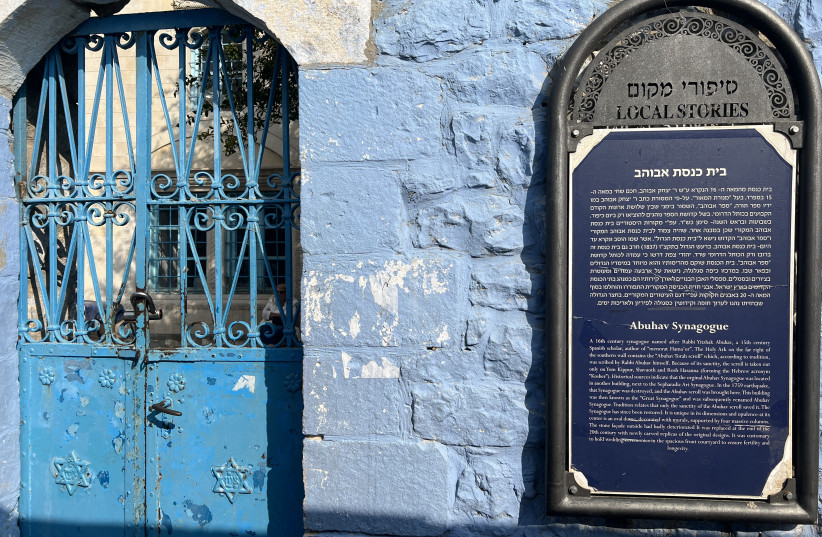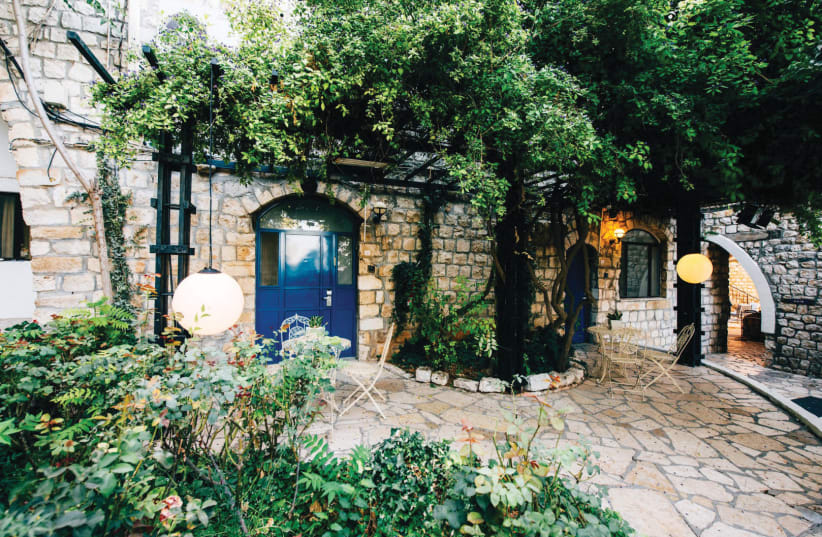The Ruth Safed Hotel, located in Safed’s Old City, offers a breathtaking view of Mount Meron and northern Israel. In 2019, the Dan Hotel chain acquired the long-established Ruth Hotel, which has a unique intermingling of old and new in a remarkable structure with ancient stone rooms and beautiful arches.
The hotel, built on the site of an 800-year-old khan (inn) that hosted travelers on pilgrimages to the Land of Israel and convoys of merchants, has 40 guest rooms. It is located in the heart of the Artists’ Colony, and its picturesque cobblestone lanes lead to numerous mesmerizing attractions, such as ancient synagogues, which are a testament to the city’s extensive and colorful history, art galleries, jewelry makers and artisans’ studios, a cheesemaker who uses traditional methods to make Safed cheese, wineries, and an ancient Crusader fortress.
Moreover, the Ruth Safed Hotel recently opened a wine bar called Muza, which serves wines from boutique wineries located all around the Galilee and Golan Heights. Because the bar is situated in an ancient Mamluk building, its eclectic ambiance can turn the experience of going out for a glass of wine into a journey back in time.
Muza is open to the public, not just the guests of the Ruth Safed Hotel. But it certainly is convenient to enjoy a glass or two of wine, and then just saunter up to your hotel room.
Among the wines at Muza are Lueria, Golan Heights, Odem Mountain, Galil Mountain, Abouhav, Delta, Recanati, Carmel, Scoria and Kerem Ben Zimra.


Muza also offers an array of local boutique beers and cocktails made with spirits that are distilled in distilleries in northern Israel. There really aren’t many other venues in Safed that offer exciting nighttime activity, but that’s okay, since Muza is an incredible place that offers a wide variety of quality beverages.
And, of course, we wouldn’t want you to have too much to drink on an empty stomach, so you’ll be happy to know that Muza has a great dinner menu. It includes salads prepared from farm-to-table fresh produce from local farmers, fried finger food, Galilean roasted eggplant, spicy stuffed cabbage, Safed cheeses and traditional Lebanese desserts.
All the hotel guest rooms have a view of the hills of the Galilee and Mount Meron. During the summer months, the outdoor semi-Olympic pool is a popular spot for local and foreign tourists. The hotel also has a gym, sauna, kids’ playground, an herb garden, as well as lots of quiet corners where you can relax with a glass of wine.
For November, prices range from NIS 880 to NIS 1,630.
The Ruth Safed Hotel
STAYING OVERNIGHT at the Ruth Safed Hotel is ideal for anyone interested in joining a guided tour of Safed’s Old City. Alternatively, you can walk around on your own and discover all the gems in this ancient Jewish town. Since all the shops and galleries in Safed are closed on Shabbat, I recommend beginning your tour of the city Friday morning if you’re visiting on the weekend. If you plan to travel there during the week, then any time of the day is fine.
I personally love to wander around old cities like Safed without a specific plan to visit any particular place. The Old City is relatively small, so it doesn’t matter what order you visit each attraction. Each time you duck into a famous synagogue, a popular art gallery or a quaint boutique, you’ll be able to hear stories from locals and store owners about the city’s rich history. Safed also has an especially religious Jewish feel to it, and it’s interesting to see the juxtaposition of the old traditions with the eclectic people who currently call Safed home.
Geographically, Safed sits atop the majestic Mount Canaan and is surrounded by green forests and crisp air. Safed is thought to be the ancient town that Josephus Flavius fortified and wrote about in the first century CE, in anticipation of fighting that would later break out against the Roman Legion. Safed was captured time and again, including during the Crusader and Mamluk periods, and also as part of the Ottoman Empire. Safed suffered many natural disasters, such as a fierce earthquake in 1837, but throughout its long history, the city remained the world capital of Kabbala (Jewish mysticism).
Many of the synagogues that have been in use for centuries, such as the Ari Synagogue and the Abuhav Synagogue, still actively function as houses of prayer. I highly recommend that you visit these and other synagogues.
Dozens of people attend daily services at the magnificent Ari Synagogue, named after Rabbi Isaac Luria, and is known for its colorful and ornate ark that holds the Torah scrolls. It is considered one of the oldest synagogues in the country that is still in use. To get there, climb up the ancient stone stairway known as Olei Hagardom, which had been the barrier separating the city’s Jewish and Muslim quarters.
Next, continue on to Hameganim Square, and from there to the Abuhav Synagogue, which is named after Rabbi Yitzhak Abuhav, a renowned 15th-century Spanish rabbi. The synagogue incorporates Kabbalistic symbols in its design and is known for its beautifully designed oval-domed ceiling, blue and green walls, brilliant light fixtures and three holy arks. After you’ve finished visiting the various synagogues, I recommend patronizing the various boutiques and art galleries in the Old City area.
If you’d like to include a short hike in nature in your visit to Safed, go to the Emek Hatechelet Park, located just five minutes by car from the hotel. There are two trails in the park – one is 800 m. long, and the other a bit longer – both of which will lead you to waterfalls (which are not flowing with water yet, since Israel’s rainy season has just begun).
Both paths will bring you to Ein Techelet (Ein a-Zarka), for which the park was named. You will see spring water flowing out of a wall, which was built to support the road above it, and that connects Meron and Safed. The water from the spring flows into a large square pool.
Translated by Hannah Hochner.
